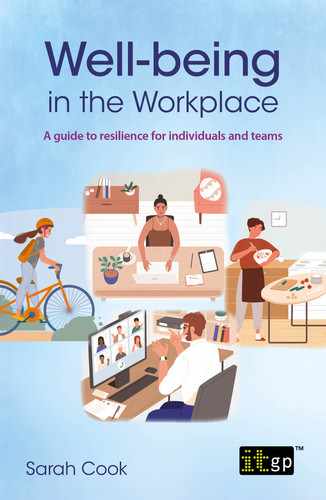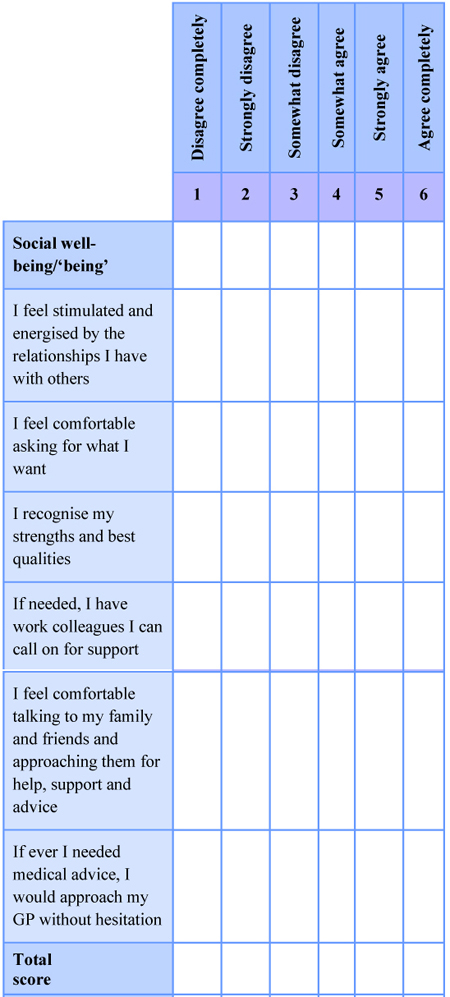CHAPTER 3: ASSESS YOUR OWN LEVELS OF RESILIENCE
This chapter provides a resilience self-assessment inventory for you – and your team – to use. It will highlight your areas of strength and help you identify where you can improve your resilience. The following chapters then provide ideas on how you can develop such resilience skills.
Resilience self-assessment inventory
Complete the self-assessment below as honestly as possible. There are no right or wrong answers, so please be honest.
Table 5: Physical Resilience Assessment

How to interpret your scores
| Total score: | |||
| Physical well-being | Emotional well-being | Mental well-being | Social well-being |
| ….. | ….. | ….. | ….. |
My highest score(s): …..
My lowest score(s): …..
My total resilience score (the combination of all four category scores): …..
The questionnaire is designed to assess your total resilience as a whole person. Your relative levels of physical, emotional, mental and social well-being contribute to your overall resilience levels.
Look first at your overall score:
•A score of 120 and above indicates high levels of resilience.
•A score between 95 and 119 indicates average levels of resilience.
•A score between 60 and 94 indicates low levels of resilience.
•A score between 0 and 59 indicates very low levels of resilience.
Next, highlight which of the four categories you scored highest and lowest in.
Table 9: High and Low Scoring Categories
| Highest scoring category | Lowest scoring category |
|
|
The four energies and why they matter
Physical energy
Our physical energy determines our ability to respond positively and proactively when we are challenged, things don’t go our way or we are stressed. Living a healthy lifestyle helps our resilience in the following ways:
•Seven to eight hours sleep a night allows us sufficient sleep to recharge our batteries.
•Drinking water throughout the day hydrates us and improves mood and brain function as well as energy levels.
•Eating a balanced diet gives us the right ‘fuel’ to keep our energy levels high.
•Regular exercise boosts our feel-good factors, lowers blood pressure and counters stress.
•Taking regular breaks away from our desk and switching off from work while on holiday helps us maintain a sense of perspective.
Emotional energy
Knowing and accepting who you are and what you stand for helps build your emotional energy or ‘feeling’. Having a sense of purpose helps provide meaning in your life. It also helps us to identify our passions and to stay focused on what is important. We can draw on emotional energy when things go wrong as it helps put things in perspective. People with high levels of emotional well-being know what their core values are. They are clear about what brings them joy in their lives, feel valued and are appreciative of those around them.
Mental energy
Research shows that positive mental energy has a significant impact on both the body and the brain. Positive thinking produces an effect called ‘cognitive broadening’.5 This means the mind broadens its attention and thought patterns when we think positively rather than narrowing our attention and restricting thought patterns as happens when we are in a negative mental state.
By adopting a positive mental state, we:
•Can tackle more complex ideas;
•Learn more;
•See opportunities, possibilities and solutions;
•Attract others, so we are less isolated (whereas negative thinkers become more isolated); and
•Have improved health outcomes as cardiovascular function is impacted by positive emotions.
Social energy
Human beings are social creatures by nature. Social isolation can lead to high risks of illness and early death.
People who feel more connected to others:
•Have higher self-esteem;
•Have more empathy for others;
•Are more trusting and cooperative; and
•Have lower levels of anxiety and depression.
Reflection and action points from this chapter
As we come to the end of this chapter, consider what your overall resilience score tells you about where you are right now.
Look at where you scored lowest. Read the relevant chapter for hints and tips on how to improve your resilience over time.
5 Cognitive broadening is a theory developed by Barbara Fredrickson. For more information on the Broaden-and-Build Theory, see www.ncbi.nlm.nih.gov/pmc/articles/PMC1693418/.



